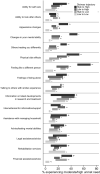Brain cancer patients' levels of distress and supportive care needs over time
- PMID: 36086830
- PMCID: PMC10087040
- DOI: 10.1002/pon.6028
Brain cancer patients' levels of distress and supportive care needs over time
Abstract
Purpose: This study aimed to describe patient self-reported distress over time and how this was associated with wellbeing, and supportive care needs over a 6-month period from commencing chemoradiotherapy for high grade glioma (HGG).
Methods: In this prospective cohort study, participants completed surveys at three time points: before chemoradiotherapy, at 3 and 6 months. These included Distress Thermometer, Functional Assessment of Cancer/Brain Cancer Treatment-general (Fact-G/FACT-BR), Supportive Care Needs Scale (SF-34) and Brain Tumour Specific subscale. Patient survival time was also collected. Group-based trajectory modelling was performed. Multinominal logistic regression assessed variables associated with different distress trajectory groups.
Results: One hundred and sixteen participants completed assessments at baseline, 89 participants at 3 and 64 at 6 months. Four distress trajectory groups were identified; consistent low distress (18%), low to high distress (38%), high-to low distress (24%) and consistent high distress (19%). Younger participants tended to report decreased distress over time, whereas older participants reported consistently high distress. High distress trajectory participants had less education, lower physical wellbeing, more unmet needs, but higher functional wellbeing compared to the low to high distress trajectory. The number of unmet needs paralleled the patterns of distress over time. The highest unmet needs in people with HGG and high distress were disease specific changes in mental ability and physical side effects.
Conclusion: This study demonstrates people with HGG experience ongoing distress and highlights a need for continuous distress and unmet needs screening and referrals.
Keywords: brain tumours; high grade glioma; longitudinal study; patient distress; supportive care needs.
© 2022 The Authors. Psycho-Oncology published by John Wiley & Sons Ltd.
Conflict of interest statement
The authors have no relevant financial or non‐financial interests to disclose.
Figures




References
-
- Baker PD, Bambrough J, Fox JRE, Kyle SD. Health‐related quality of life and psychological functioning in patients with primary malignant brain tumors: a systematic review of clinical, demographic and mental health factors. Neuro Oncol. Pract. 2016;3(4):211‐221. 10.1093/nop/npv042 - DOI - PMC - PubMed
-
- Stupp R, Hegi ME, Mason WP, et al. Effects of radiotherapy with concomitant and adjuvant temozolomide versus radiotherapy alone on survival in glioblastoma in a randomised phase III study: 5‐year analysis of the EORTC‐NCIC trial. Lancet Oncol. 2009;10(5):459‐466. 10.1016/s1470-2045(09)70025-7 - DOI - PubMed
-
- van den Bent MJ, Tesileanu CMS, Wick W, et al. Adjuvant and concurrent temozolomide for 1p/19q non‐co‐deleted anaplastic glioma (CATNON; EORTC study 26053‐22054): second interim analysis of a randomised, open‐label, phase 3 study. Lancet Oncol. 2021;22(6):813‐823. 10.1016/s1470-2045(21)00090-5 - DOI - PMC - PubMed
Publication types
MeSH terms
LinkOut - more resources
Full Text Sources
Medical

